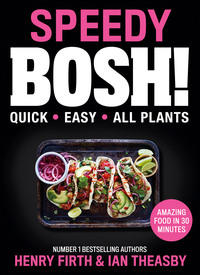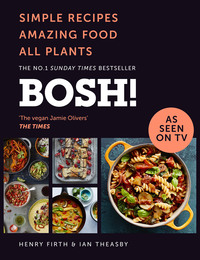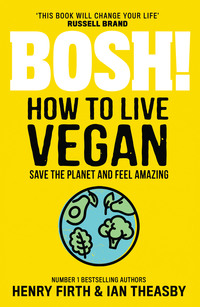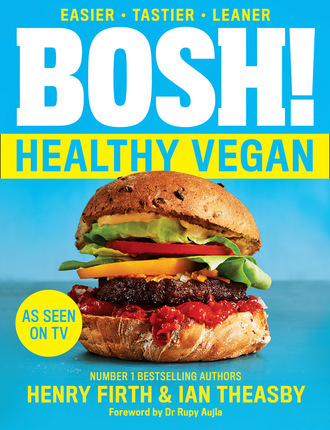
Полная версия
BOSH! Healthy Vegan
Both of us were making bad life choices. And these poor choices were making us unhealthy, unfit and unhappy.
As January approached, Ian decided to give up alcohol as a personal challenge. He found it easier than he expected, so decided to up the ante and give up meat, too. As part of that process, he started reading up on meat production, and watching veggie and vegan YouTube videos. And he decided to go vegan.
We lived together (and still do) and shortly after Ian decided to go vegan, we watched the film Cowspiracy. On discovering the environmental, health and ethical impact of animal agriculture, Henry joined Ian and went vegan overnight too.
Almost instantly, we both felt amazing. We lost a bit of weight. Our energy levels improved. We felt generally lighter, as our digestive systems were less strained. Our hair got thicker and we slept better. Henry’s hayfever pretty much disappeared. We felt fitter and healthier than ever. Despite the fact that it was harder to find food (in 2014 there wasn’t as much choice for vegans), we felt more satisfied and more fulfilled by our choices. The overall positivity of the vegan experience was intoxicating, and so we set up BOSH! to share our love of vegan food with the world.
The rest is vegan history. Within months we had millions of views of our videos. Within a year, billions.
However, there was a downside. While we were eating plant-based foods – which are, inherently, healthy – the sheer amount of food we were cooking and testing was causing us problems. We’re incredibly proud of the food in our BOSH! books, but, put simply, we were eating too much! Particularly for Henry, those repeated tests to make the perfect lasagne or burger resulted in him piling on the pounds he had initially lost.
When you immerse yourself in the vegan world, you realise just how easy it is to make vegan versions of almost anything. This is a great thing, as it shows that vegan food doesn’t need to be about abstinence. But, as any dietician, or medium- to long-term vegan or vegetarian will tell you, it’s easy to be an unhealthy vegan, or to just be eating the wrong things. After all, salad is vegan – but so are chips!
We found that cutting meat out of our diet was a great thing to do – it helped us eat less saturated fat, and encouraged us to bring more fibre and nutrients into our diet. A plant-based diet reduces your impact on the planet and you know that what you eat doesn’t contribute to poor animal welfare – but if you’re not careful, you can easily end up low in key nutrients.
As well as the over-eating, our increasingly busy lives negatively affected our work-life balance. We had no time for exercise. Our hectic video production schedule meant we often didn’t leave the house for days on end. When we did leave, we filled our faces with vegan burgers, vegan fish and chips and brownies at vegan food events. Gradually we became unhealthier versions of our vegan selves, living on ‘junk food vegan’ diets. At home, there were far too many takeaways. Our meals were less ‘eat-the-rainbow’ and more ‘50 shades of beige’.
Time to change.
At the start of 2018, we decided to get healthy.
It wasn’t a big change. More a re-steering of the ship. We changed our course by a couple of degrees, watched our ship right itself, and found a completely new destination.
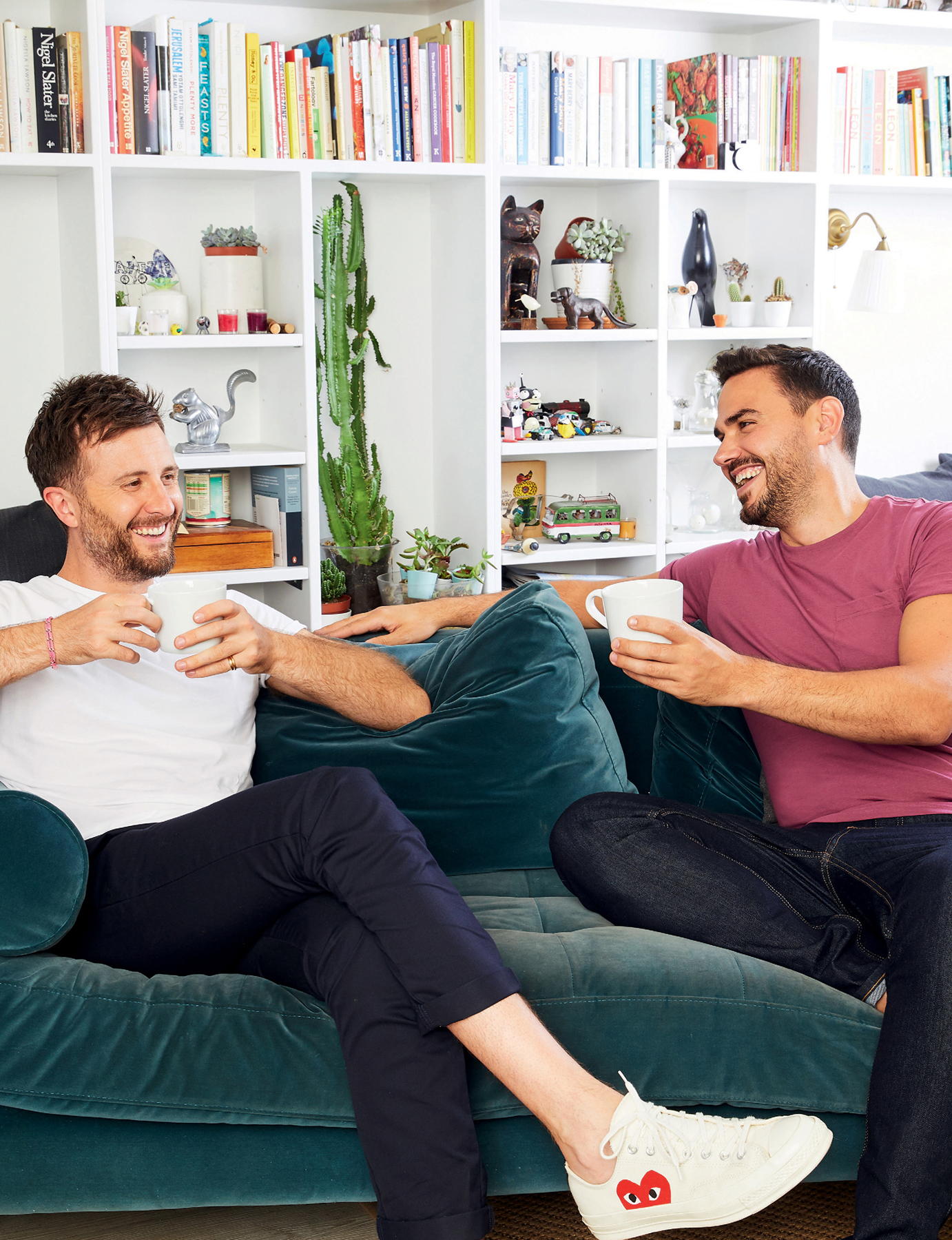
The best of times.
We sought advice everywhere we could, reading dozens of books, watching videos and documentaries, following courses and speaking to doctors and nutritionists. We sought out mentors. We started working with a dietician.
Our new way of eating and living focused on colourful plants, and getting the right balance of nutrients. This, as well as a small amount of careful supplementation, ensured we were getting exactly the right nutrition for our bodies.
Following our new meal plan felt great. We felt light and lean. We had successfully navigated ourselves to a place where we felt fantastic all week long, saved money, saved time on cooking, and were still able to eat the kind of meals we wanted (allowing ourselves to indulge in a vegan junk food session from time to time). We went to the gym regularly, and were better at getting up early. Our work has improved, our happiness has increased and we are healthier than we have ever been.
This is the toolkit we wish we’d read when we were starting out on our vegan journey. We wish we’d known that by following just a few simple steps and basic rules we could ensure we achieved optimum nutrition from a plant-based diet.
A new you.
Our goal is to help everyone in the world eat more plants. That’s what we’re about. It’s what we’ve always been about. It’s why we started BOSH! and why we’ve written our cookbooks.
We’ve updated our mission a little bit from where we started. As well as helping everyone eat more plants, we also want our recipes to inspire, entertain and nourish, and we want to improve the health of the planet and all its inhabitants. If everyone adopted a plant-based diet, we could make a big contribution to reducing climate change.
That’s why we’re here, and it’s why we created the recipes in this book. We’re here to show the why and the how of living healthily on a plant-based diet.

HOW TO LIVE WELL.
A healthy lifestyle means different things to different people. But all of us will benefit from focusing on these six pillars:
sleep, move, relax, love yourself, love others, live with purpose
A long, healthy, happy life has all these bases covered. Don’t compare yourself to others, but think about how well you feel when you follow the principles of each in your own life. We’d like to share with you some simple, meaningful changes you can make to live better.
SLEEP.
Rest is crucial for your body. During sleep our body undergoes all sorts of essential activities. Doctors recommend we aim for between 7 and 9 hours per night – any less than this counts as sleep deprivation, which can have many negative health consequences. So getting good sleep is crucial.
One of the most positive changes we made was to improve our sleep. We used to get up early to hit the gym, even if it meant getting only 5 or 6 hours of sleep. We were spending our days sleep deprived, trying to catch up at the weekends.
But after learning about the impact sleep has on physical performance, we made time to sleep properly. Now we get 7-9 hours of good-quality sleep most nights and the difference to our lives has been incredible. Even if we hit the gym a bit less often, we see more benefits from the times we do go, and we eat more sensibly during the day too, as we’re less likely to need a quick energy boost.
Being sleep deprived is detrimental to your health. It can impair brain function, memory and empathy. It negatively affects your mood and increases stress hormones. It is also more likely to cause us to make bad food choices, and since we’re tired, we are more likely to skip exercise. Being tired impairs our body’s ability to grow muscle, and conversely, makes us more likely to put on fat.
Of course, there are some jobs, such as doctors, nurses, chefs or shift-workers, which require long and erratic working hours, or night shifts. This can make a regular sleep pattern an impossibility. In this case, getting the maximum sleep possible and the best-quality sleep you can (even including naps) will help you manage your rest time.
After a good night’s sleep you’ll reap many benefits, including more energy, higher concentration and stronger learning ability. You’ll be more likely to make good food choices and your body will be better at building muscle or burning fat. Your immune system and bodily repair systems will also improve. In his trailblazing book, Why We Sleep, Matthew Walker shows that you’ll have better memory, increased life expectancy, lower stress levels and more empathy. In addition to the food you eat, sleep is one of the biggest things we want to help you with.
How to sleep well.
Create a bedtime ritual. Go to bed and wake up at the same time every day – even at the weekends – if you can.
Keep your mobile phone and TVs out of the bedroom, using something else as your alarm clock. Ian likes to use a light alarm clock, and Henry likes to wake up to a motivational podcast to get him up and raring to go! We set up a charging point in the hallway for phones.
Reduce your caffeine Intake. We used to drink up to five cups a day – that’s too many! Have your coffee in the morning, or at lunchtime, then it’s out of your system by bedtime.
Reduce exposure to bad light at bedtime. Looking at your phone or a computer screen late at night can make your body think it’s morning, due to the bright blue light your devices emit. Try to turn off technology an hour or so before bed, or if you really can’t do that, use an app that will dim the light of the screens. These are available on most mobile phones, and you can download laptop applications to do the same thing.
Put yourself on a strict sleep routine. Aim to get 8 hours of sleep a night, for a week, at the expense of all else (even exercise). See how amazing you feel. Then take it from there!
Aim to get your room as dark and quiet as possible at bedtime. If your room isn’t completely dark, try fitting blackout blinds or using a really comfortable eye mask. And ear plugs are great for helping keep sounds out – get the best ones you can.
Keep your room cool. Around 18˚C is a good temperature. If you find you are sweating, or tossing and turning, consider investing in a duvet with a lower tog rating.
Make your bed each day. Your bed should be as inviting and as comfortable as possible. Invest in some quality fitted sheets and bedding that you love.
Embrace napping. Napping is great, and it is a skill that can be learned. A 20-minute daytime nap can do wonders to revive you; even a 5-minute nap can leave you feeling refreshed. Sofas, car seats, or even at your desk at work can be great nap spots, where you can bring yourself back to alertness if you’re a little low on sleep.
Get outside first thing in the morning and get 20 minutes of daylight on your skin (not through glass, and not wearing sunglasses!). We find exercising in the morning (usually running or cycling) is a great way to do this, but see what works for you.
MOVE.
There’s a test called the sit-to-stand test, or sit-rising test, which is usually conducted on the over 50s. It analyses your overall mobility and balance, and is used to make predictions about how long you are likely to live based on your performance in the test. It involves going from standing to sitting on the floor, and then back up to standing without using your hands, arms, knees or the side of your leg to support you. When Henry was 30, he realised he couldn’t perform the simple movement in that test. It was at this point that he started regular exercise, including strength and mobility work.
Regular exercise is one of the top factors in ensuring a healthy body. Movement doesn’t have to be overly taxing, even just walking briskly for 30 minutes throughout the day counts towards an active lifestyle. The NHS recommends adults aged 19-64 aim for 150 minutes of moderate exercise or 75 minutes of vigorous exercise each week, as well as strength exercises on two or more days a week. So, whether you’re walking, running, stretching or lifting, regular movement is crucial.
As the saying goes, ‘use it or lose it’.
Most able-bodied toddlers can perform an excellent squat; humans are born with great mobility. Over time, in the West, we lose that ability – squatting just isn’t something we do on a regular basis, compared to places like India and south-east Asia where squatting to sit is common, and you’ll find most people can still perform a perfect squat. If you’re not making full use of a range of motion, it will gradually stop being available to you.
The same applies to our muscles. Your body is an efficient machine, and if you’re not using muscles, they will start to deteriorate. These changes are not immediately noticeable, but before you know it you can get a sprain from performing a simple task. Your muscles need to be adequately maintained across their whole range of movement, otherwise even a small movement outside of their norm can end up causing damage.
In addition to loss of mobility and strength, overly tight and inflexible muscles can cause damage elsewhere in your body, as you may be holding yourself awkwardly to compensate. Back pain is often actually caused by tightness in the legs and glutes, and the longer tightness is left, the harder it is to solve with stretching or conditioning.
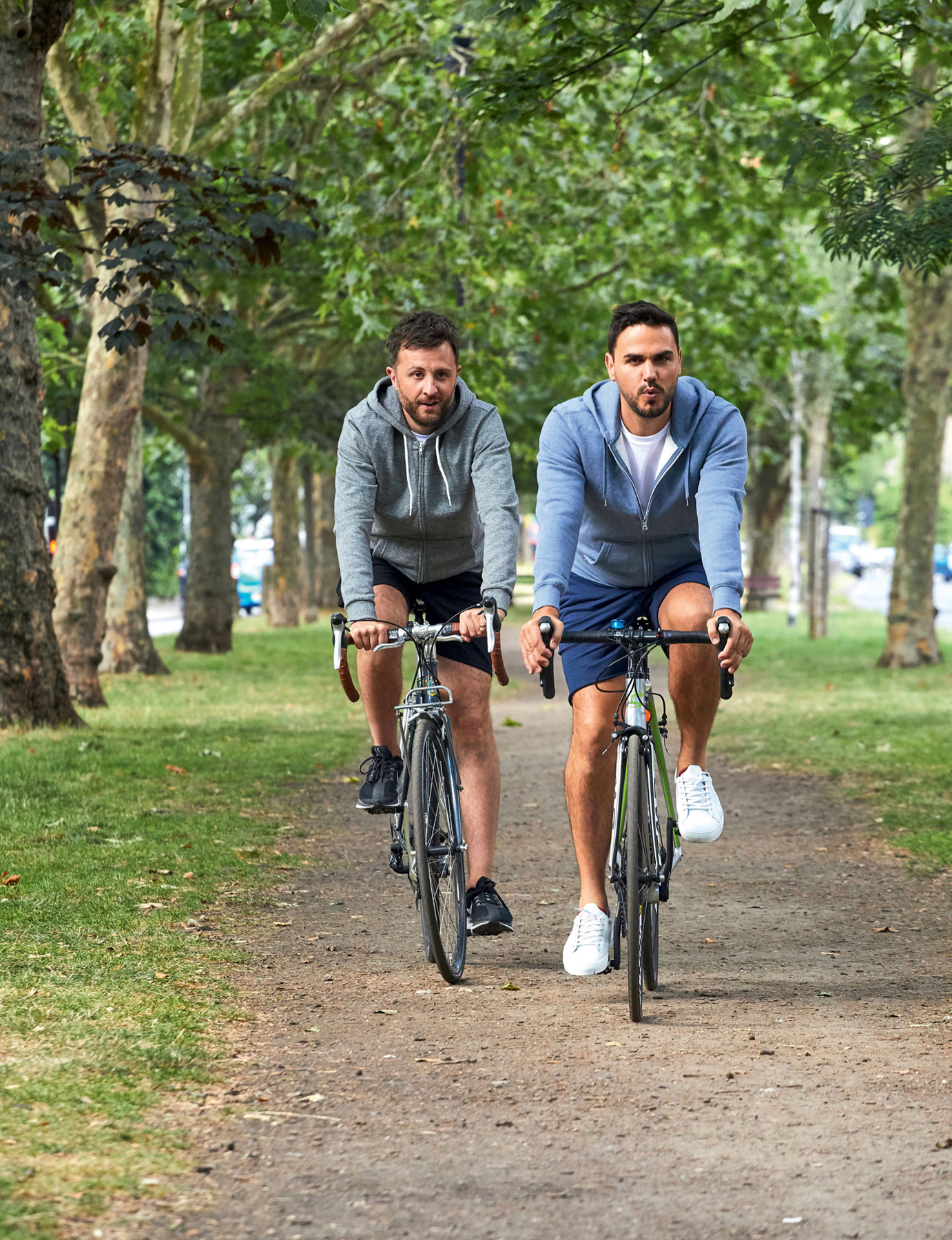
Exercise is also the number one way to look after your heart. Heart Rate Variability (HRV) is one of the best measurements of health, and also serves as a good indicator of how well your heart is working. Increasing your heart rate on a regular basis will help preserve the heart’s health.
The best gift you can give your future self is that of agility and strength. Look after your body, as it’s the only place you have to live.
Move daily.
Make an effort to move on a daily basis, by including it in your daily routine. This may involve active hobbies, like going to the gym or a class, or could be simply walking to the bus stop twice a day. Just make choices that involve your body moving as much as possible.
A cool way to track this is with a smartphone or smartwatch. 10,000 steps is commonly used as a target to aim for each day, and trackers for this can be found on almost all smartphones and smartwatches now. You could use a wall chart instead, and simply note down 30 minutes of active movement on a daily basis. Whatever you do, try to move every day.
Or try ‘exercise snacking’: moving regularly for short periods throughout the day. Look for ways to introduce extra activity: do you have a long work phone call scheduled? Could you do it while you go for a walk? Or if you have to travel to a meeting, can you incorporate some walking or cycling into the journey? If we have a meeting a few miles away and the weather’s nice, we like to cycle, to help us keep active.
Exercise your heart weekly.
Two or three times a week, do something that gets you breathing hard and your blood pumping. This could involve a run, a cycle or simply a fast walk, but find a way to make it a bit strenuous. You need to be breathing hard enough that it’s difficult to have a conversation. If you’re able to talk to someone easily, you’re not working hard enough.
Alternatively, if you’re a gym goer, do some cardio, a high-intensity-interval-training (HIIT) workout, or simply lift weights faster! If you wear a smartwatch, then you’re looking for an elevated heart rate as a sign that you are pushing your heart to work harder. Get that blood pumping to keep your heart fit. The heart is literally a muscle, and we want to make sure we keep it nice and strong.
Strengthen your muscles weekly.
As we get older our muscles start to deteriorate. One of the best ways to fight this is to continually build muscle mass through strength training. The more muscle you have, the longer it will last.
We’re not talking about building an Olympic body here – although it’s up to you if you want to do that! We’re talking about pushing your body to get strong and to build and retain muscle.
There are many ways to do this, but you might try cycling, rock climbing, yoga, Pilates, lifting light weights or following fitness DVDs or YouTube videos – whatever works for you. Of course, you could use a personal trainer too, although that can be quite an expensive option. There are plenty of strength-based classes at the gym or in local parks, or you can just do it at home.
And stretch ….
Flexibility and mobility are two sides of the same coin. You want to be flexible enough that your joints and muscles can move through a large range of motion. We’re not suggesting you should be able to do the splits, but being able to touch your toes is a good indicator of hamstring flexibility.
Ian has tight shoulders, and an area of focus for him has been working on raising his arms straight above his head. This might sound simple but many of us have shoulders too tight to do this. And these limitations in flexibility can cause issues further down the line.
Mobility means that you have strength throughout your range of flexibility. So, in Ian’s case, he doesn’t just want to be able to reach his arms straight above his head, but also to be able to carry a weight safely through the whole range of motion. Your goal should be to improve your flexibility and mobility at the same time.
Regular stretching is great for building flexibility. If you’re sitting in front of the TV on a rainy Sunday, then why not run through some gentle stretches at the same time? You can find loads of follow-along stretch videos on YouTube, and once you’ve learned them you won’t need the videos any more.
Yoga is perhaps one of the best and most popular ways to build both flexibility and mobility. Pilates and barre work wonders too, as does Tai Chi. Martial arts are also good choices, as are rock climbing, gymnastics and calisthenics.
Another crucial part of improving mobility is breaking up tight muscle fibres. We all know what it feels like to have knots in our muscles, whether they’re in our shoulders, back or glutes. These are muscle fibres that have stuck together, and it’s important to break them up to get good flexibility and range of motion. This can be done through massage, but not all of us can afford weekly massage sessions! The best way to do this for yourself is with an inexpensive foam roller – ideally one with little knobs on. Find a follow-along video class where they’ll show you how to use the roller to ease up tension in your muscles.
Find a form of exercise that you love.
Whatever you choose to do, find an exercise that you love and make it part of your regular routine, aiming to exercise three to five times per week.
In the last few years, we have adopted a regular calisthenics and gymnastics schedule. We absolutely love it. We’re not just lifting more weights, but at every session we achieve goals or levels that we would have never thought possible. When we started, we could barely do push-ups or pull-ups. Now we can perform them with ease, and we’re working on handstands and doing cool flips on gymnastics rings. It makes every gym session fun!
Maybe you have a room at home where you can follow fitness video classes. Or maybe you prefer a gym class before or after work. We like to get our workouts done in the morning, so we can begin the day having worked out.
Commit to getting started by trying one type of exercise for a week. Make it a priority in your day – just like you’ve done with sleep. And see how much better you feel at the end of the week.
Find the right kind of exercise for you, as that’s the only way you’ll keep it up. Try different classes or home workouts until you find one that resonates with the way you want your body to move. You might fall in love with Zumba, or weight training. Or you might prefer to become a supple gymnast or Pilates master. Or perhaps 5am karate sessions in the park are more your thing.
Find a form of exercise you love and make it part of your regular routine, for a longer, happier life.
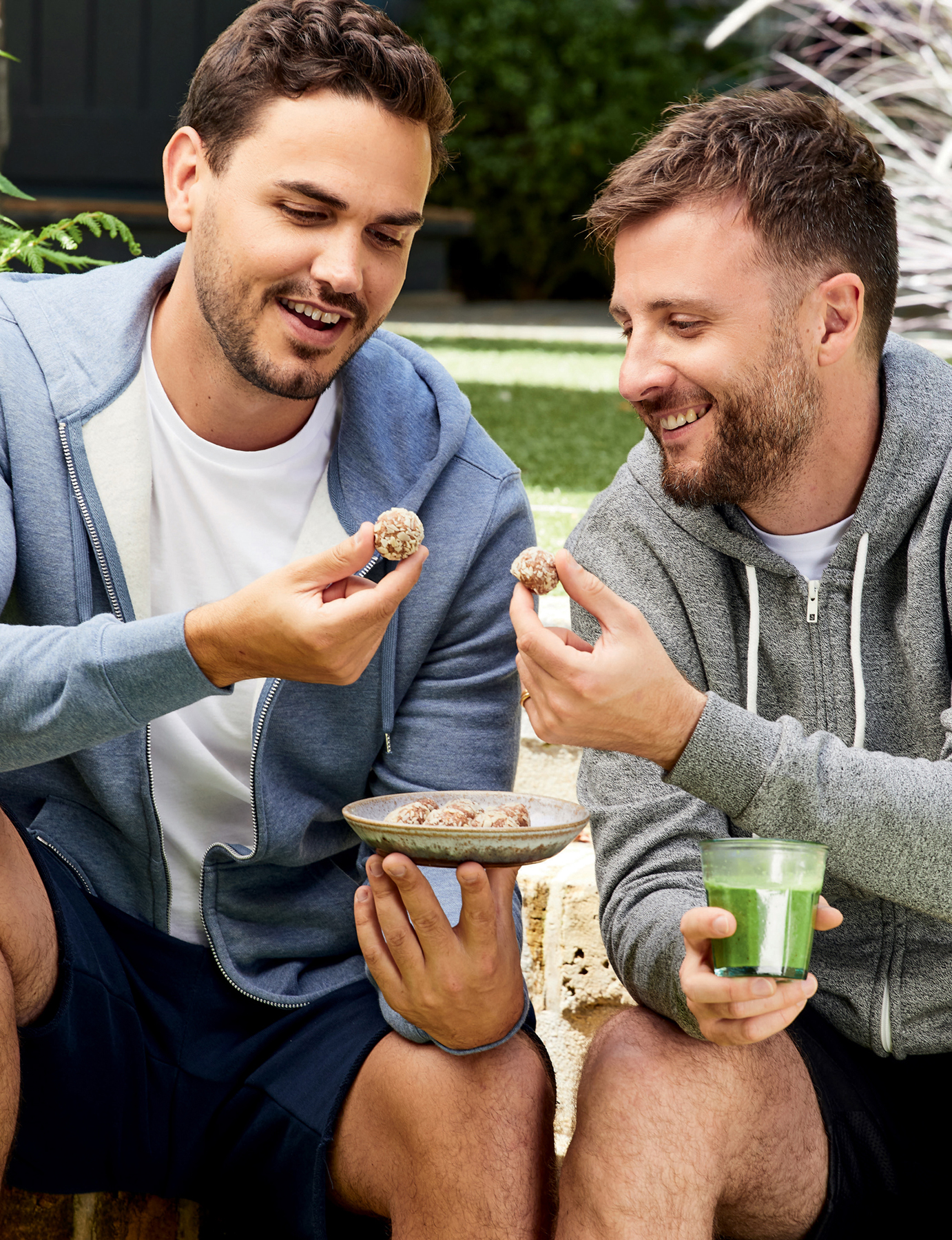
RELAX.
Most of us are generally not that great at relaxing. We live busy, frantic lives running from task to task, constantly spinning plates. With no downtime, your brain is constantly in a state of stress. When you are overwhelmed with stress, your body is constantly in fight-or-flight mode, with high cortisol levels (cortisol is our body’s stress hormone) which can lead to longer-term health consequences. Finding an opportunity each day to relax really helps to reduce stress and promotes a more positive attitude to life.
Relaxing on a daily basis can give you a new default mode. Instead of being like a stretched elastic band, constantly under pressure, you’ll find yourself existing in a more relaxed state of mind most of the time. If something stressful does happen it’s easier to deal with from a state of calm. It will also give you a more balanced view on life. You’re less likely to lash out at those you love, and in difficult negotiations you will be more flexible. You’ll find you sleep better too, and might even find it benefits your exercise and general fitness. See? It all fits together beautifully!
Learn to meditate. Meditation is perhaps the most commonly talked about form of relaxation. Many people practise meditation or mindfulness on a daily basis to help quiet their minds. Apps like Headspace or Calm are great for this (we use both): you can practise meditating daily for 5, 10, 15 or even 30 minutes, and you’ll experience benefits from the first session. If you prefer, attend meditation classes and learn the principles from a teacher, which you can then apply to your own practice. Forms of prayer work to quieten the mind, too, and both prayer and meditation have been linked to populations who live longer.
Focus on what you’re grateful for, and let your internal voice thank the universe for that thing. Did you feel stressed? Probably not. It’s hard, if not impossible, to be stressed while feeling grateful. Gratitude is a practice, almost like a muscle, that can be strengthened through daily exercise. Spend some time each day, either just in your mind or writing in a journal or on your phone, focusing on three things you are grateful for. This will help calm your mind, give you a more positive outlook and reduce stress.
Factor in some ‘me-time’. We consider our morning workouts as ‘me-time’. They help clear our minds and give us a really positive boost for the day ahead. Me-time is different for everyone – just think about what it is you like to do (which doesn’t involve a screen) and find a way to do some of it every day. We love to cook, and even though it’s what we do for our daily work, we still find cooking for ourselves in the evening to be relaxing. Other examples include reading, crossword-puzzles, gardening, walking the dog, taking a long bath, yoga or deep-breathing exercises. Even tidying the house can be a relaxing activity if you do it right. Whatever you do, find a way to get a bit of relaxing me-time into your day. Your body, mind and soul will benefit.




